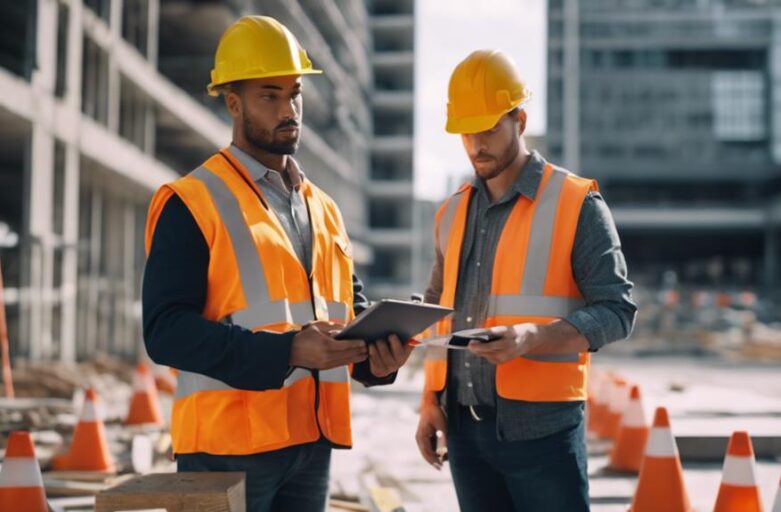Checking out buildings safely is super important. First, you have to dress right. Wear safety glasses, a hard hat, and gloves. Make sure you can see well, so have strong lights. Stay focused all the time. If you're dealing with electricity, always check if it's turned off and double-check the connections.
Going into tiny spaces like crawl spaces? Dress up in the right gear and watch out for anything dangerous. Make sure any ladder you use is sturdy. When you're looking at the structure of a building, pay extra attention to the foundations and walls.
Sometimes, buildings might have nasty stuff like mold, so always have the right protection gear. Keep your tools in top shape by servicing them regularly. Always learn about the latest safety practices. Also, think about using digital tools to make inspections easier.
Lastly, keep looking for more ways to keep yourself safe during inspections.
Key Takeaways
- Put on your safety gear like goggles, a hard hat, and gloves before you start checking the building.
- Keep an eye on your surroundings. Take note of the weather and how much light there is. Make sure someone knows where you are.
- Be careful when dealing with electricity. Test outlets and switch off the power before you start your inspection.
- If you need to go into small, tight spaces, be cautious. Watch out for things that could hurt you like loose insulation and wires. Also, be safe when using a ladder.
- Look at the building's structure. Check the foundation, walls that hold up the building, and the condition of the whole building.
Understanding Personal Protective Equipment
When inspecting a building, it's crucial to wear Personal Protective Equipment (PPE). This gear protects you from possible dangers. Safety glasses, a hard hat, and work gloves are your main protection tools.
Safety glasses protect your eyes from things like dust or small objects that could harm them. They're more than just a requirement; they're like a trusted friend that keeps you safe from unknown dangers.
A hard hat is another essential tool. It protects your head from objects that might fall while you're inspecting a building. In this job, you need not only knowledge and skill but also bravery and endurance.
Work gloves are like shields for your hands, preventing cuts and scrapes that could affect your work. They silently help you as you explore every nook and cranny during your inspection.
Being a building inspector involves more than just knowing stuff. You also need to follow safety rules. The safety glasses, hard hat, and gloves aren't just tools; they're part of who you're as a professional.
Importance of Environmental Awareness
Understanding our environment is really important, especially when we're checking buildings to make sure they're safe. This means paying attention to things like the weather, how much light there is, and even telling other people where we are.
Let's talk about these one at a time.
First up, weather. If it's raining or really windy, it could be dangerous to do an inspection. So, keeping an eye on the weather helps us stay safe and stop accidents from happening.
Next, we have light. Imagine trying to find your way around a dark room – you might bump into something, right? It's the same with building checks. Having good light means we can see everything clearly and avoid any nasty surprises.
Thirdly, telling people where we are. This is a bit like when your mom or dad wants to know where you're going when you leave the house. If something happens, they can come and help straight away.
Lastly, there are rules that people who do these inspections have to follow. These aren't just there for the sake of it – they're designed to keep everyone safe and stop any risks from getting out of hand.
| Thing to Think About | Why It's Important | How It Helps Us |
|---|---|---|
| Weather | Helps us plan for safety | Stops accidents |
| Light | Makes sure we can see everything | Avoids surprises |
| Telling People Where We Are | Makes sure help is nearby | Keeps us safe |
| Following Rules | Makes sure we're doing things safely | Stops risks |
Guidelines for Electrical Safety
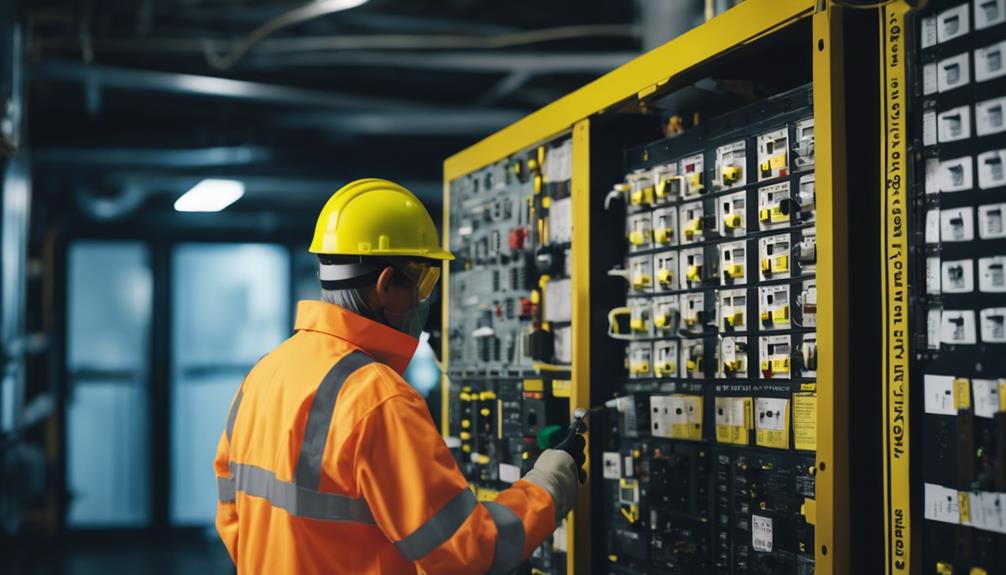
When you're checking out electrical setups, being safe is the top priority. Make sure to look for any grounding or shaky connections. Don't forget to test plug-ins and double-check that GFCIs are put in correctly.
Keep your eyes open for common dangers. These could be outlets that are too old, wiring that's not secure, or fuses that are too big. This way, you'll make sure your inspection is both safe and works well.
Inspecting Electrical Systems
Ever wondered how to stay safe while looking at electrical systems? It's all about getting ready and using the right safety gear. Put on your safety gear first. This includes glasses, gloves, and a hard hat. Then, get a trusty voltage tester.
With this, you can check for any risky wiring or grounding issues. Make sure to check Ground Fault Circuit Interrupters and test outlets too. These are crucial safety parts that people often forget about. Always turn off the power before you start your inspection. This way, you lessen any danger.
Avoiding Electrical Hazards
Looking at electrical systems is essential, especially to keep us safe. As part of a group that appreciates safety, we need to remember some crucial steps while checking homes.
The first step is to make sure our electrical sockets are working right and are safe to use. This way, we can avoid unexpected shocks. If we're in a damp place, we can use a special device called a GFCI to protect us from shocks.
It's also important never to touch bare wires and always to turn off the electricity before we start looking around. We should be on the lookout for wires that aren't properly connected, old and worn-out plug sockets, and fuses that are too big. These things can be dangerous. We need to stay away from power lines and use tools that have an insulating cover.
Navigating Crawl Spaces Safely
Crawl spaces are small areas under buildings that you might need to go through during inspections. It's really important to do this safely. Think of it like being a secret agent on a mission. You don't just need to be good at squeezing through small places, but you also have to be ready with special gear. Plus, you need to watch out for things like bugs, loose wires, or tiny particles in the air that might hurt you. Let's break down how to stay safe in crawl spaces.
First, gear up. Just like a superhero doesn't go into battle without their suit, you need your protective equipment. This might include a hard hat, gloves, and a mask. It's like your very own safety armor.
Second, be alert. You don't know what you might find in a crawl space. There could be bugs or even rodents. There might be wires that aren't secured properly. And sometimes, the air can have small particles that aren't safe to breathe in. So, always be ready for anything.
Essential Protective Gear
With the right safety gear, you can safely explore crawl spaces. You need a strong ladder and tough boots to protect your feet from sharp things. Safety goggles will keep your eyes safe from dust.
You should also wear a mask, as crawl spaces can be very dusty. This will help keep your lungs clean. A flashlight will help you see in the dark, narrow spaces.
Before you go in, check for any small animals or bugs. Also, watch out for loose insulation and wires that could trip you. Remember, we're all working together to keep building inspections safe and easy.
Crawl Space Hazards
Heading into crawl spaces can be risky. These tight and dark spots can hide all sorts of dangers, like unexpected animals or things that can make you trip. It's important to be careful and understand these dangers.
Wearing the right safety gear is key. A mask can keep your lungs safe from dusty air. Gloves and boots protect you from hurting your hands and feet on rough stuff or sharp things. Watch out for loose insulation and wires. They're not just things to trip over, they can cause worse injuries. Be alert, stay safe and encourage others to do the same.
Safe Inspection Practices
When you're inspecting places like crawl spaces, it's super important to keep safe. Wearing the right stuff is key. Think of a mask, gloves, and kneepads as your safety squad. They keep you from breathing in dust, protect your hands, and keep your knees comfy during the inspection.
Make sure to stay sharp! A flashlight is your secret weapon to spot any hidden bugs or creepy crawlies. Also, pay attention to where you step. Stuff like loose insulation and bare wires can be sneaky dangers.
Remember, your safety is number one! Good airflow stops harmful gases from building up. Check out this cool table that breaks down these safety steps. It's made to help you be part of our gang that's all about staying safe.
| Safety Gear | What to Do | Why It's Good |
|---|---|---|
| Mask, gloves, kneepads | Put on before going in | Stops dust, keeps you comfy |
| Flashlight | Use to light up dark spots | Helps find possible dangers |
| Careful inspection | Look for loose insulation, wires | Stops accidents from happening |
| Ventilation | Make sure there's enough air | Stops bad gases from building up |
Ensuring Ladder Safety
When doing building inspections, you need to be very careful when using a ladder. It's important for everyone in our inspection team to stay safe.
Before you climb, check your ladder. Look for things like cracks or loose parts. It's very important to make sure your ladder is safe for use.
Make sure your ladder is at a good angle. It's not just about getting high up, it's about staying safe while doing it. Always keep three parts of your body touching the ladder. This could be two hands and a foot, or two feet and a hand. Remember, this is about safety, not showing off balance skills.
Choose a ladder with non-slip feet to stop it from moving. Don't stretch too much or lean too far to one side. This isn't a race, it's about being careful. Staying safe on the ladder is as important as the inspection job itself.
Checking Structural Integrity
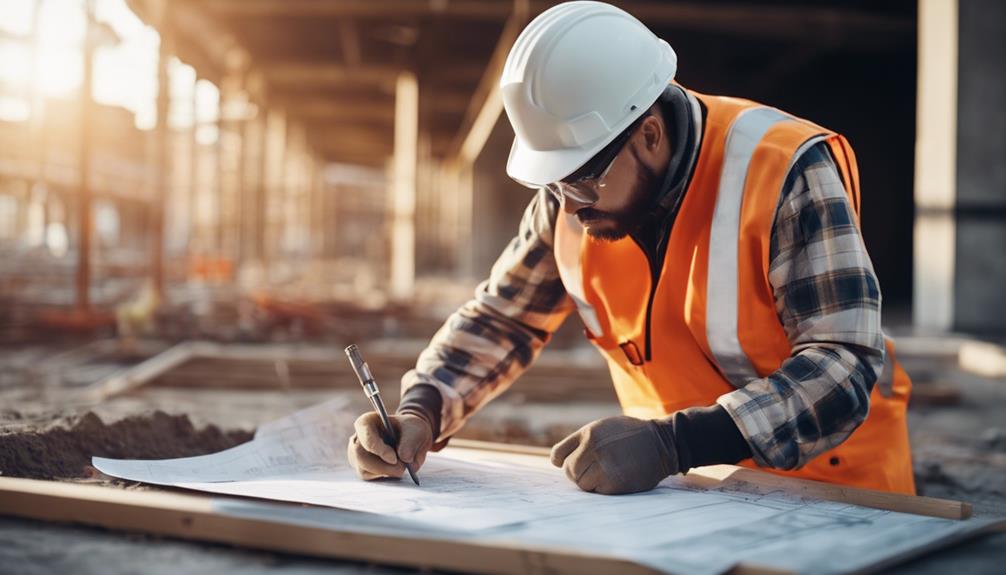
Once you're safe on your ladder, the next big job is to look at your building's strength. You need to be like a detective, looking for clues like cracks or sagging in the foundation that could make the building unstable. This isn't just a quick look, it's like a deep dive into a mystery.
Also, pay attention to the load-bearing walls. These walls are like the skeleton of your building, and if they're weak, it could be really bad. Look for any walls that are bending or shifting, as these are signs they might need help.
Don't forget, you don't have to do this alone. You can hire a structural engineer, who's like a doctor for buildings. They can check everything over and give you peace of mind that your building is safe.
Here's an easy checklist to help you:
| Area | What to Check |
|---|---|
| Foundation | Cracks, sagging, shifting |
| Strong Walls | Bending, shifting |
| Ceilings and Floors | Damage signs |
| Overall Condition | Water damage, mold, mildew |
This job is really important. When you check everything over, you're making sure the building is safe for everyone inside. So, it's a big responsibility, but it's also one you should be proud of.
Protection Against Harmful Substances
Checking out buildings isn't just about looking at walls and rooms. It's also about keeping yourself safe from stuff you can't see, like asbestos, mold, and lead paint.
It's super important not to forget your safety gear, especially masks, when you might come across these harmful things. Knowing how to spot these dangers and deal with them properly is the best way to keep you and everyone else safe.
Identifying Harmful Substances
Safety in buildings is very important. You need to watch out for dangerous stuff like asbestos and mold. Asbestos is often found in old buildings and it can make you very sick.
You also need to remember about things you can't see, like carbon monoxide. This gas can be really dangerous and is called a silent killer.
Fire safety isn't just about putting out fires. It's about knowing what can start them too. Look for any signs of water damage as this can lead to mold and mildew. These are often found in wet or stuffy places.
Your safety is very important. So, you need to not only spot these dangerous things but also know why they're dangerous and how to deal with them.
Protective Gear Usage
Your safety gear is like a superhero's armor when you're checking out buildings. Think of a respirator mask as your invisible shield, keeping your lungs safe from bad stuff like asbestos.
Imagine your safety glasses as your secret goggles, keeping your eyes safe from tiny particles in the air.
Gloves? They're your superhero gloves, protecting your hands from nasty things like mold or chemicals.
Your coveralls are like your superhero suit, keeping your regular clothes safe.
And never forget your superhero boots, your closed-toed shoes, which keep your feet safe from sharp things or dangerous materials.
Proper Care for Inspection Tools
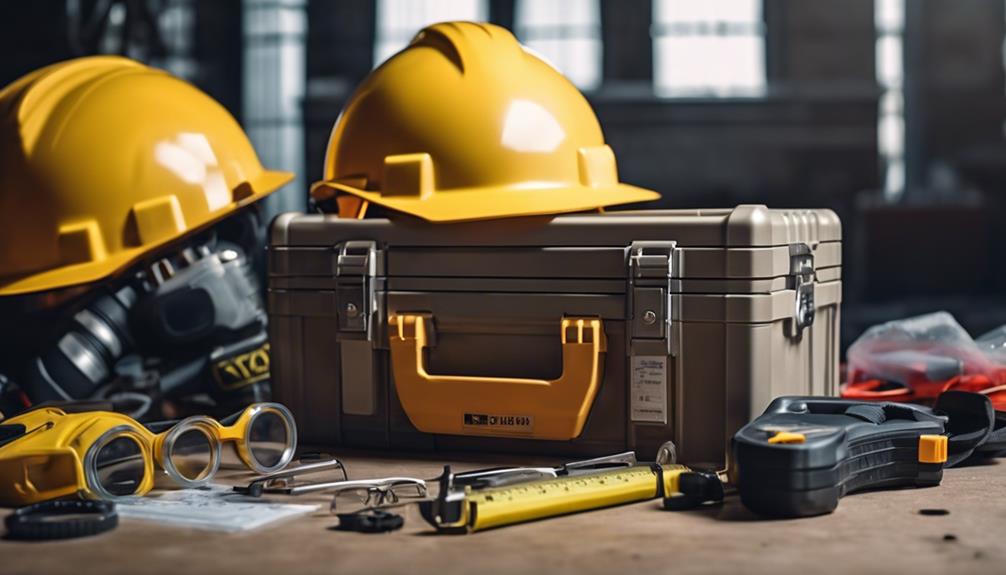
Taking care of your inspection tools is super important. It's not just about making them last longer; it's about keeping everyone safe. It helps avoid accidents and makes the job of inspecting buildings smoother. You need to keep your tools in top-notch shape. Check them often to see if they're worn out or damaged. If something doesn't seem right, tell your maintenance team right away. They're there to help ensure you have good, safe tools to work with.
Make sure to wear your safety gear when you're using tools, even just for maintenance. Tools can be dangerous if they're not used right, so always be careful. Keep your tools stored in a tidy and organized way. This reduces chances of accidents and makes it easier to find what you need.
If you have a new tool or a new piece of tech, take some time to learn about it before using it. The goal isn't just to get the job done, but to do it safely. Putting money into good tools and keeping them in good condition isn't a waste, it's a must. It's for your safety and the safety of your team, and to make your inspections more efficient. If you take care of your tools, they'll do a good job for you.
The Need for Continuing Education
Continuing education is more than just learning new things. It's about keeping up with the latest changes in your work field. It helps you to know about the newest safety rules and the latest tools in your industry. It's not just about you, but a team effort where everyone needs to join in.
Think about joining safety workshops. These don't just refresh what you know, they also teach new ideas and ways of doing things. They help you to add more tools to your toolset, keeping you up-to-date in your field.
Being part of a home inspection group is more than just a cool thing to add to your resume. It's about becoming part of a team of people who care about making buildings safe. You get a chance to learn from others in your field and keep up with new changes and trends.
Benefits of Comprehensive Inspection Software
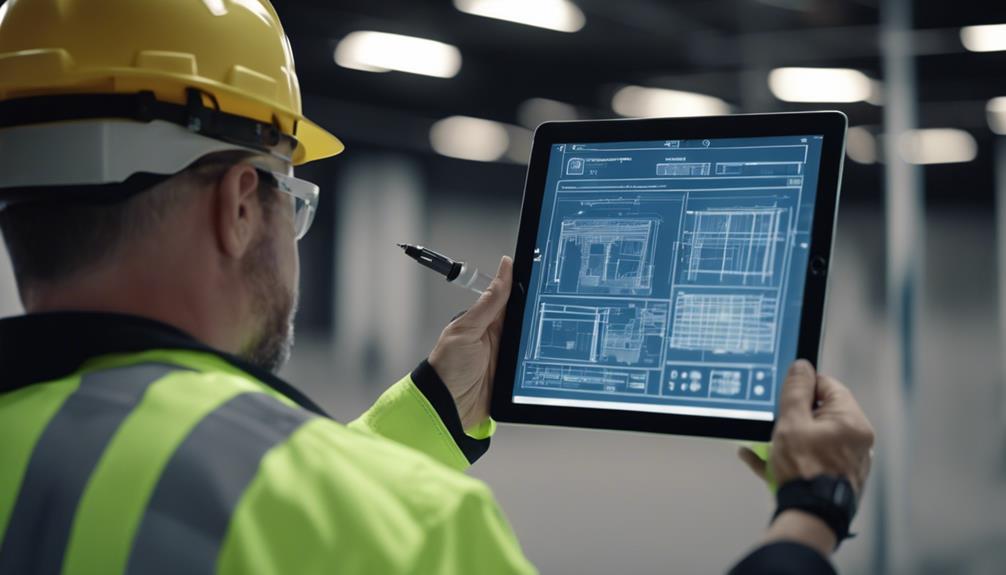
Inspection software is like a super tool that makes your inspections a lot easier. Think of it as a computer program that organizes all your data and reports in a way that's really efficient. It's not just a fancy gadget, but a real help that can totally change the way you do inspections.
This software lets you make detailed reports with photos and videos, making them look really professional. It also makes working with your team and clients a breeze, as you can easily share information and make sure everyone knows what's going on.
You can also customize this program for different inspections, like checking a roof, without having to make a new layout every time. This saves you a lot of effort and keeps you from needing to run around a lot.
Plus, you can use this software on your phone or tablet, which means you can do your work wherever you are. This makes you more flexible and helps you get more done during inspections.
Having inspection software is really beneficial. Once you start using it, you'll probably wonder how you ever did inspections without it.
Conclusion
Alright, you've become a pro at staying safe during building inspections. You know all about wearing the right gear to protect yourself, being mindful of your surroundings, and handling electricity with caution.
You've mastered moving around in tiny spaces, using ladders without risk, and shielding yourself from harmful stuff.
You're clued up on looking after your tools, always learning more, and the advantages of using software for inspections.
Remember, staying safe is an ongoing process. Always keep learning, stay alert, and make sure every inspection goes off without a hitch.


